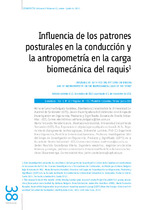Influencia de los patrones posturales en la conducción y la antropometría en la carga biomecánica del raquis

Ver/
Fecha
2013Autor
Delgado Gamboa, Adriana Carolina
Maradei García, María Fernanda
Castellanos Olarte, Javier Mauricio
Tipo de contenido
article
Citación
Metadatos
Mostrar el registro completo del ítemDocumentos PDF
Resumen
La incomodidad generada por la postura estática prolongada en jornadas largas de conducción obliga a los sujetos a realizar cambios posturales constantes que les permiten liberar tensión en el raquis y aumentar la percepción de comodidad. Para comprender cómo el tiempo y la condición de salud influyen el número de cambios posturales creados en dicha tarea, y cómo la carga biomecánica es afectada por el factor postura y antropometría, se registraron y evaluaron por medio de un modelo biomecánico las posturas de veinte hombres entre veinte y cuarentaicinco años de edad. Se halló que más que los cambios posturales ligados a la condición sintomática y a la antropometría del individuo, es la postura la que influye en la fuerza intradiscal en el disco L5/S1. Es así como el diseño de puestos de trabajo más ergonómicos deben considerar la posición de la pelvis y sus efectos en la carga intradiscal. The discomfort generated by long hours of driving in static posture, forces subjects to make constant postural changes that allow them to release tension on the spine and increase the perception of comfort. To understand how time and health conditions influence the number of postural changes used in this task and how the biomechanical load is affected by the posture and the anthropometry factor, twenty men between 20 and 45 years of age were registered and evaluated by means of a biomechanical model. The study showed that the posture rather than postural changes linked to the symptomatic condition and the anthropometry of the individual affected the intradiscal force on the L5/S1 disc. This shows how the effects of the position of the pelvis on the intradiscal load should be considered when designing more ergonomic work stations.
Palabra/s clave
Postura sedente
Cambios posturales
Dolor lumbar
Flexión de cadera/pelvis
Sitting posture
Posture changes
Lumbar pain
Hips/pelvis position
Colecciones
- Vol. 9 No. 12 (2013) [12]
El ítem tiene asociados los siguientes ficheros de licencia:

